A Signal Timing Method to Reduce the Emissions in Arterials (Case Study: Enghelab Avenue in Ahvaz)
Omid Rezvan1 * , Seyed Abbas Tabatabaei1 and Marziyeh Yoosefi1
1
Department of Civil Engineering,
Shahid Chamran University,
Ahvaz,
Iran
Corresponding author Email: Rezvanomid@Gmail.com
DOI: http://dx.doi.org/10.12944/CWE.10.Special-Issue1.03
Actuated signal control is very efficient for isolated intersections, but along arterials it lacks the means to synchronize signals, leading to high delays and frequent stops which produce high emissions and fuel consumption. This research aims to use new paradigms based on actuated control that can lead signals to synchronize with their neighboring intersections resulting in reduction of emissions, fuel consumption and travel time in the arterials. In this research, traffic signal coordination software Synchro 8 was used to coordinate the signals on closely spaced intersections in Enghelab avenue in Ahvaz. In order to evaluate the effectiveness of proposed control logic, a simulation test bed was developed in the traffic simulation model SimTraffic 8 and 3D viewer 8.The Proposed logic resulted in total travel time, emissions and fuel consumption reductions of up to 25.6 %, 12.61% and 16.4% respectively compared to current condition logic in Enghelab avenue.
Copy the following to cite this article:
Rezvan O, Tabatabaei S. A, Yoosefi M. A Signal Timing Method to Reduce the Emissions in Arterials (Case Study: Enghelab Avenue in Ahvaz). Special Issue of Curr World Environ 2015;10(Special Issue May 2015). DOI:http://dx.doi.org/10.12944/CWE.10.Special-Issue1.03
Copy the following to cite this URL:
Rezvan O, Tabatabaei S. A, Yoosefi M. A Signal Timing Method to Reduce the Emissions in Arterials (Case Study: Enghelab Avenue in Ahvaz). Special Issue of Curr World Environ 2015;10(Special Issue May 2015). Available from: http://www.cwejournal.org/?p=10
Download article (pdf)
Citation Manager
Publish History
Select type of program for download
| Endnote EndNote format (Mac & Win) | |
| Reference Manager Ris format (Win only) | |
| Procite Ris format (Win only) | |
| Medlars Format | |
| RefWorks Format RefWorks format (Mac & Win) | |
| BibTex Format BibTex format (Mac & Win) |
Article Publishing History
| Received: | 2014-11-14 |
|---|---|
| Accepted: | 2014-11-28 |
Introduction
Efficient Signal control plays a primary role in increasing traffic capacity and reducing signalized intersection delay. Increased traffic capacity helps reduce congestion, which in turn eliminates the need to widen roadways, thereby improving efficiency while maintaining a smaller roadway footprint (Cesme, 2013). Actuated signal control is very efficient for isolated intersections but among arterials it lacks the means to synchronize signals, leading to frequent stops (FHWA, 2008). Signal coordination is essential for reducing delays and stops on arterials having closely spaced intersections. It provides green waves for arterial Traffic and makes progression for vehicles. Current control plans in many arterials, are not able to make good progression.
One of the most challenges that transportation professionals are faced with is the reduction of travel time in the network, increasing traffic capacity in order to reduce traffic delays while minimizing the magnitude of construction. One approach to deal with that challenge is to improve the efficiency of traffic signal controllers to ensure more efficient use of existing roadway capacities (Cesme, 2013). Efficient signal control plays a primary role in increasing traffic capacity and reducing signalized intersection delay. Increased traffic capacity helps reduce congestion, which in turn eliminates the need to widen roadways, thereby improving efficiency. Signal control is very efficient for isolated intersections but along arterials it lacks the means to coordinate traffic signals which lead to frequent stops.
Materials and Methods
In this research, signal coordination is performed based on actuated control. The control type is Actuated-Coordinated in which all phases other the assigned coordinated phases are fully actuated (FHWA, 2005). The signal operates on a fixed cycle length and unused time in the cycle is added to the assigned coordinated phases. Two important features of actuated-coordinated control are Force-Off and Lead-lag phasing. In an actuated-coordinated signal, each phase has a start time and an end time. The end time is the force-off point for actuated phases and the yield point for coordinated phases (Trafficware, Ltd., 2011).When the coordinated phases reach their first yield point, the phases enter the Ready to Yield state. While in the Ready to Yield state, the signal can yield to any actuated phase when its start time appears (Traffic ware, Ltd., 2011).Once all the coordinated phases yield, the signal enters Yielded state. In Yielded State, all actuated phases are serviced in turn until the actuated the actuated phases reappear (FHWA, 2005).
Force-Off
For Uncoordinated phases, controllers use force-off, that is, points in the cycle where Uncoordinated phases have to end their green time even if there is continued demand. Force-off ensures that coordinated phases will receive their pre-specified green time and ensures that intersection offsets and cycle length will be maintained (Trafficware,Ltd., 2011). With Force-Off operation, any unused time from actuated phases can be used later by other actuated phases. Each actuated phase is terminated when it gaps out, or at its yield point, whichever comes first. An Actuated phase can also be terminated at its max time if Fixed Force off is not used (Cesme, 2013).
Lead-Lag Phasing
At closely-spaced signals with protected left turn phases, staggering arterial through phases using lead-lag configuration (i.e., allowing a leading turn phase at one intersection and lagging at another) rather than starting simultaneously, improves two-way coordination. Using lead-lag configuration also limits wasted green time, because the green time that is wasted (starved) until vehicles arrive at the next intersection (the disadvantage of simultaneous green start for good two-way progression) can now be efficiently used by serving left turn phases (Trafficware, Ltd., 2011). So for signal coordination in this research, Lead-Lag optimization and force-off operation are proposed.
Simulation Construction & Results
To evaluate the proposed control plans, Enghelab avenue in Ahvaz was chosen. There are three closely spaced intersection ( Enghelab-Sheikhbahaa, Enghelab –Naserkhosro and Enghelab-Amirkabir intersections) On Enghelab avenue with Actuated-Uncoordinated signals. In this research, traffic signal coordination software Synchro 8 was used to coordinate and optimize the signals on closely spaced intersections in Enghelab avenue in Ahvaz ( Transportation Research Board, 2002). In order to evaluate the effectiveness of proposed control logic, a simulation test bed was developed in the traffic simulation model Sim Traffic 8 and 3D viewer 8. In the simulation environment, current traffic control logic was compared with proposed control logic on Enghelab arterial avenue. The distance between intersections was obtained through Google Earth using the ruler tool. Figure (1) shows the Enghelab arterial and its intersections. The intersections are marked by yellow circles.
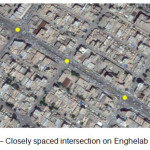 |
Fig. 1: Closely spaced intersection on Enghelab avenue Click here to View figure |
Table (1) shows the current control timings for each intersection on Enghelab avenue.
Table1: Current control timing of all three intersections on Enghelab avenue
|
Arterial through split (s) |
Cross street through split(s) |
Turning split(s) |
Min Green(s) |
Gap time(s) |
Arterial yellow(s) |
Cross street yellow(s) |
All-red time(s) |
Number of phases ( Dual ring) |
|
45 |
45 |
7.5 |
6 |
7 |
3 |
3.5 |
0.5 |
6 |
Through and Turning Movements Volume
Through and turning movements volumes for each intersection were obtained from Ahvaz Municipality Transport and Traffic Organization. The passenger car equivalents were obtained from Department of Housing and Urban Development regulations. Peak hour volumes for each intersection were selected. Total peak hour volume was 4609, 4498 and 4159 vph for Enghelab-Sheikhbahaa, Enghelab-Naserkhosro and Enghelab-Amirkabir intersection respectively.
Arterial Design and Control Plans in Synchro 8
To start the simulation, signal coordination and optimization software, Synchro was used. Synchro is a macroscopic analysis and optimization software application. Synchro supports the Highway Capacity Manual’s methodology (2000 & 2010 methods) for signalized intersections. Synchro’s signal optimization routine allows the user to weight specific phases, thus providing users more options when developing signal timing plans. synchro minimizes the total delay for Vehicle passing the arterial also cross streets.
For Geometric arterial construction in Synchro, the feature to import the Bing maps to construct the arterials and cross streets were used. So the Enghelab avenue map was imported in software and construction was performed using the related tools. Figure (2) shows the arterial and cross streets construction in Synchro 8.
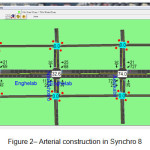 |
|
For current condition in Enghelab avenue, the detector distance to stop bar is 1 meter in each intersection. Arterial has 3 lanes in each direction with width of 3.6 m and cross streets have 2 lanes in each direction with width of 3.6 m.Travel speed in arterial is 60 km/h. Synchro report showed the LOS C for Enghelab-Sheikhbahaa and Enghelab-Naser-Khosro and LOS E for Enghelab-Amirkabir intersection.
Simulation of the Current Traffic Condition in Simtraffic 8
After designing the arterial and cross streets in Synchro, a simulation test bed was developed in SimTraffic 8 simulation software. SimTraffic is a powerful, easy-to-use traffic simulation software application. SimTraffic performs micro-simulation and animation of vehicular and pedestrian-related traffic. With SimTraffic, individual vehicles are modeled and displayed traversing a street network (Trafficware,Ltd., 2014). Fuel consumption in SimTraffic is calculated using following formulas (Trafficware,Ltd., 2011):
F=Total Travel*K1+Total Delay*K2+Stops*K3 (1)
K1=0.075283-0.0015892*Speed+0.000015066*Speed^2
K2=0.7329
K3=0.0000061411*Speed^2
F represents fuel consumption in gallon and other parameters are as follow:
Speed=cruise speed in mph
Total Travel=vehicle miles traveled
Total Delay=total signal delay in hours
Stops=total stops in vehicles per hour
Theses are the same as the default formulas for fuel consumption used by TRANSYT 7-F.
The emissions calculations are based on fuel consumption as follow (Trafficware,Ltd.,2011):
CO=F*69.9 g/gal= Carbon Monoxide Emissions (g) (2)
NOX=F*13.6 g/gal= Nitrogen Oxide Emissions (g) (3)
VOC=F*16.2 g/gal= Volatile Oxygen compounds Emissions (g) (4)
Figure (3) shows the 3D viewer simulation.
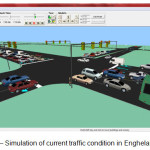 |
|
The simulation results for the current traffic condition showed the total travel time of 36.7 hr, total emissions of 9362 gr and the total fuel consumption of 89 liters.Table (2) shows the emissions produced by vehicles in detail:
Table2: Emissions produced by vehicle in Enghelab avenue for current condition
|
HC ( gr) |
CO (gr) |
NOX (gr) |
|
226 |
8311 |
825 |
Optimizing the Control Plans with Proposed Logic Implemented in Synchro
One of the powerful features of Synchro is that it can optimize the order of phases. When optimizing offsets, Synchro will check all combinations of leading and lagging phasing so as to improve traffic flow. So in this research control type was set to Actuated-Coordinated and Lead-Lag phasing was activated for all arterial phases for each intersection. The Enghelab-Sheikhbahaa was the master intersection for the critical V/C ratios of it's approaches. Synchro also supports Force-Off operation for actuated-Coordinated control. so, this feature was activated for all arterial and cross streets through phases in the software and all timings and offsets were optimized.
Synchro report showed the LOS B for Enghelab-Naserkhosro and LOS C for Enghelab-Amirkabir intersection.
After optimizing the control plans and implementing the proposed logic, a simulation test bed was developed in SimTraffic 8. The simulation results showed the total travel time of 27.3 hr, total emissions of 8181 gr and the total fuel consumption of 74.4 liters. Table 2 shows the emissions produced by vehicles in detail:
Table3: Emissions produced by vehicles in Enghelab avenue after optimization
|
HC ( gr) |
CO (gr) |
NOX (gr) |
|
173 |
7360 |
648 |
The graphs showed in figure (4) and Figure (5) indicate the comparison between current control plans and proposed control plans after optimization performed by Synchro.
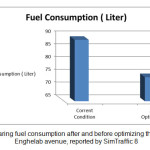 |
|
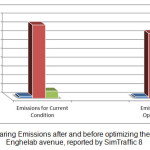 |
|
Discussion and Conclusions
using proposed control plan to coordinate the signals on Enghelab avenue, Synchro report showed the improvement of LOS from C to B for Enghelab-Naserkhosro and from E to C for Enghelab-Amirkabir intersection. Increase in LOS by two level is very substantial and indicates the importance of proper signal coordination. Also, the results indicate the difference between actuated-uncoordinated and actuated-coordinated control. After optimization, the simulation reports showed that Proposed logic resulted in reductions of HC,CO and NOX emissions up to 53,951 and 177 gr respectively or reductions of emission up to 12.61% in total compared to current control plan in Enghelab avenue. Also, the simulation reports showed total fuel consumption reductions of 16.4 % and total travel time reductions of 25.6 % compared to current control logic in Enghelab avenue. The results are considerable and indicate the success of proposed logic implemented in Synchro. It is obvious that how signal coordination can reduce the costs caused by fuel consumption and produce a healthier air in arterial, because the lower fuel consumption and travel speed due to the lower stops will lead to lower emissions.
Further work is required to investigate long-term impacts of operational-level traffic improvement Projects and to quantify the potential benefits of applying coordinated adaptive signal control for Enghelab avenue using SynchroGreen, a software-based ASCT implemented in the field, and simulated using Synchro and SimTraffic software.
Acknowledgments
The authors would like to acknowledge the constructive critique provided by Dr. Seyyed Abbas Tabatabai, Dr. Shahin Shabani and Dr. Seyyed Jafar Hejazi.
Furthermore, the authors would like to acknowledge the assistance of Mojtaba Moazedi (ITS manager of Ahvaz municipality) in the data collection effort.
References
1. Cesme, B. Self-organizing traffic signals for arterial control. Civil Engineering
2. Dissertations. 20-25(2013)
3. FHWA. Traffic Control Systems Handbook. FHWA-HOP-06-006(2005)
4. FHWA. Traffic Signal Timing Manual. FHWAHOP-08-024(2008)
5. Trafficware, Ltd. Traffic Signal Timing Manual. (Trafficware,Ltd.,2011) 6. Trafficware, Ltd. planninganalysis-software. Retrieved 2 May 2014 from:
7. http://www.trafficware.com(2014).
8. Transportation Research Board. Traffic Analysis Software Tools.
9. (Circular No. E-CO14). National Research Council(2002).






